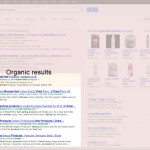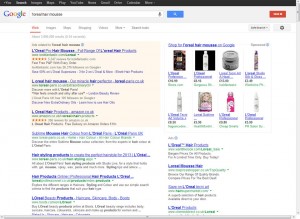Google’s new PLAs or Product Listing Ads to you and me, are the latest addition to the Google paid advertising stable. Managed through your Adwords account they present image ads, not unlike image results, at or near the top of your search results page. Trouble is that due to this similarity they tend to intercept organic traffic that would normally remain organic and so drag potential free traffic from the organic search results page into the paid realm.
Your SERP – search engine results page, is now often 75% paid ads above the fold. It is claimed by Google that using PLAs increases conversion rates significantly – which it often does but at the expense of your organic traffic.
Think about it – right in the site line beneath the top paid text ads, or to their right in the super prime spot, there are now product image ads.

Whether viewing a webpage, magazine page, road sign, or the forest for potential threats – we subconsciously pre-interpret what we are looking at so that we know instinctively where to focus our attention first – its a psychological fact – that’s how we as visual animals work. Something to do with not being eaten by predators I expect. Anyway, modern communication mediums rely on this natural principal so that, a webpage for instance, can be designed for you to instinctively interpret it’s content without too much conscious effort and so feel comfortable and safe, and so you don’t lose interest and leave the site, taking your money with you.
In the past the balance between organic search results and paid ads was fairly balanced – in fact in the early days it was positively generous – you could naturally and easily tell the difference and feel comfortable and safe in the process.
Now you cannot. PLA’s have taken up sometimes another 25% of the page and, often replacing images results, overshadow text content completely. And look how similar they are to image results. a slight of hand to make them look innocent and encourage their use. And use them we do – we will probably see future search becoming more and more image biased – it is so much easier for us as animals – different parts of the brain see?
And as Google Shopping is now populated solely by PLAs through Adwords it’s content and usefulness has actually declined. It is now just another paid for – and at times, pretty expensive, shopping service.
As marketeers, we also must contend with a less transparent and less straight forward management system for PLA implementation compared with text ads ie: connect a data feed and [Google say] optimise that feed to improve your performance. The net result is that you are bidding against your own text ads, your own organic rankings, and if you are lucky, occasionally your competitors. This leads to higher costs, greater complexity, less choice for the customer, less chance for the sites that spend years becoming great based upon their content, and lots more money for Google.
There is a self-destructive “critical” point in the growth cycle of a modern business where driving force behind it’s development tips in favour of the accountants. No longer is the dream in control. No longer is the aim to improve the long term business prospects but boost short term profits. And when that happens, your users start to notice. And someone else comes along with a nice clean slate and it all starts again. But not with you, you have lost your ideals, and there are alternatives, and maybe it’s time for a change.
STAY IN THE LOOP
